
The Katipunan, officially known as the Kataastaasang Kagalanggalangang Katipunan ng mga Anak ng Bayan and abbreviated as the KKK, was a revolutionary organization founded in 1892 by a group of Filipino nationalists Deodato Arellano, Andrés Bonifacio, Valentin Diaz, Ladislao Diwa, José Dizon, and Teodoro Plata. Its primary objective was achieving independence from the Spanish Empire through an armed revolution. It was formed as a secret society before its eventual discovery by Spanish authorities in August 1896. This discovery led to the start of the Philippine Revolution.
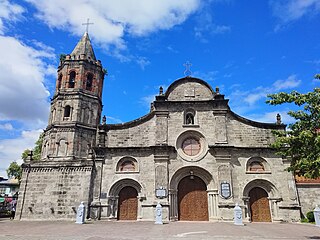
Bulacan, officially the Province of Bulacan, is a province in the Philippines located in the Central Luzon region. Its capital is the city of Malolos. Bulacan was established on August 15, 1578, and part of the Metro Luzon Urban Beltway Super Region.

Bulakan, officially the Municipality of Bulakan, is a 1st class municipality in the province of Bulacan, Philippines. According to the 2020 census, it has a population of 81,232 people.

Malolos, officially the City of Malolos, is a 1st class component city and capital of the province of Bulacan, Philippines. According to the 2020 census, it has a population of 261,189 people. It is the capital city of the province of Bulacan as the seat of the provincial government.

Aliaga, officially the Municipality of Aliaga, is a 2nd class municipality in the province of Nueva Ecija, Philippines. According to the 2020 census, it has a population of 70,363 people.

Amado Vera Hernandez, was a Filipino writer and labor leader who was known for his criticism of social injustices in the Philippines and was later imprisoned for his involvement in the communist movement. He was the central figure in a landmark legal case that took 13 years to settle.
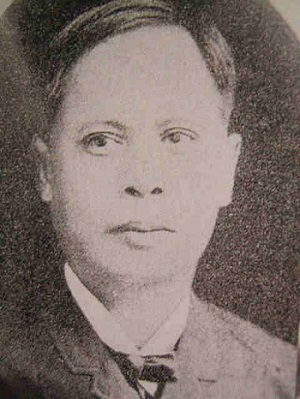
Deodato Arellano y de la Cruz was a Filipino propagandist and the first president of the Katipunan, which was founded at his home in Azcarraga Street, Manila. He was first to be given the title Supremo by the Katipunan. After studying bookkeeping in Ateneo de Municipal de Manila, he became an assistant clerk for the Spanish military. He was a member of the Freemasonry in the Philippines and became involved in the Propaganda Movement.
Louie Jon Agustin Sanchez, a poet, fiction writer, critic, and journalist, hails from Flora, Apayao, Philippines. He lives in Novaliches, Caloocan, in Metro Manila.

Francisco "Soc" Aldana Rodrigo was a Filipino playwright, lawyer, broadcaster, and a Senator of the Philippines from 1955 to 1967.
"Sa Aking Mga Kabatà" is a poem about the love of one's native language written in Tagalog. It is widely attributed to the Filipino national hero José Rizal, who supposedly wrote it in 1868 at the age of eight. There is not enough evidence, however, to support authorship by Rizal and several historians now believe it to be a hoax.
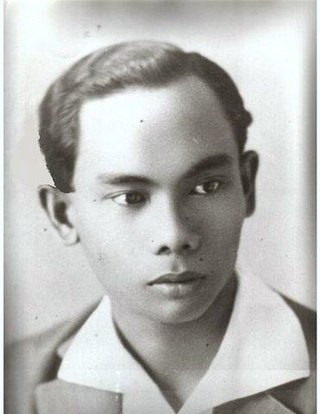
Alberto Segismundo Cruz was a Filipino poet, short story writer and novelist. Three of his novels have been published by Ateneo de Manila Press.
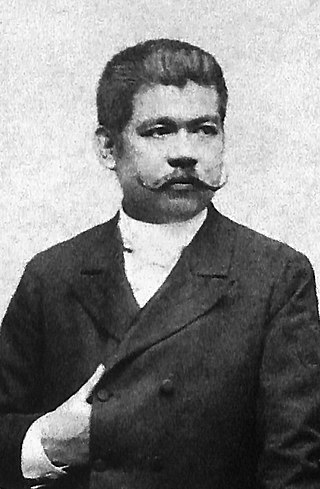
Marcelo Hilario del Pilar y Gatmaitán, commonly known as Marcelo H. del Pilar and also known by his nom de plumePláridel, was a Filipino writer, lawyer, journalist, and freemason. Del Pilar, along with José Rizal and Graciano López Jaena, became known as the leaders of the Reform Movement in Spain.
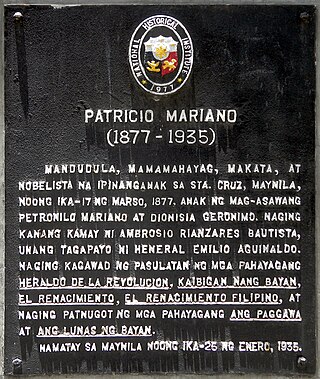
Patricio Mariano y Geronimo, son of son of Petronilo Mariano and Dionisia Geronimo., was a Filipino nationalist, revolutionary, pundit, poet, playwright, dramatist, short story writer, novelist, journalist, violinist, painter, and a Katipunan member.
Ernani Joson Cuenco was a Filipino composer, film scorer, musical director, music teacher and Philippine National Artist for Music. He wrote an outstanding and memorable body of works that resonate with the Filipino sense of musicality and which embody an ingenious voice that raises the aesthetic dimensions of contemporary Filipino music. Cuenco played with the Filipino Youth Symphony Orchestra and the Manila Symphony Orchestra from 1960 to 1968, and the Manila Chamber Soloists from 1966 to 1970. He completed a music degree in piano and cello from the University of Santo Tomas where he also taught for decades until his death in 1988.

The Uitangcoy-Santos House is an early 20th-Century bay-na-bato structure along FT Reyes Street in Barangay Sto. Nino, in the city of Malolos, Bulacan, in the Republic of the Philippines. The home belonged to Paulino Santos—a Propetario and Cabeza de Barangay, and Alberta Uitangcoy-Santos—who was the leader of The Women of Malolos, and is revered for her contributions to Philippine women's rights, the fight for Philippine independence, and a large part of Malolos' traditional cuisine during the Spanish and American colonial periods. The Uitangcoy-Santos House has been declared a national heritage house by the National Historical Commission of the Philippines, and is currently a privately owned museum that houses four exhibit halls and a lecture hall. The museum currently showcases collections of surviving artifacts and other memorabilia relevant to the narrative of the women and the Uitangcoy-Santos family.

The Marcelo H. del Pilar Shrine is a declared national shrine by the National Historical Commission of the Philippines in honor of Filipino lawyer, poet and propagandist Marcelo H. del Pilar. Located at Sitio Cupang, Brgy. San Nicolas, Bulakan, Bulacan, the shrine is the former site of the house of the del Pilar clan. Currently, the shrine is under the management of the National Historical Commission of the Philippines.
Alberta Uitangcoy-Santos was the leader of The Women of Malolos, and is revered for her contributions to Philippine women's rights, the fight for Philippine independence, and a large part of the traditional cuisine of the city of Malolos, Bulacan, in the Philippines during the Spanish and American colonial periods. She is known as the matriarch of the Uitangcoy-Santos House, which has been declared a national heritage house by the National Historical Commission of the Philippines, and currently houses the Museum of the Women of Malolos which is now curated by her fifth-generation grandson, Carlo Herrera.

Mga kababayang dalaga ng Malolos, also known by its alternative English title To the young women of Malolos, is a letter written by Filipino author and political reformer José Rizal on February 22, 1889. It is written in Tagalog and is addressed to a group of women from Malolos, Bulacan who successfully lobbied the Spanish colonial government to allow them to open a school so that they could study the Spanish language.
Edgardo "Ed" Caluag is a Filipino celebrity paranormal investigator in supernatural/paranormal phenomena. He appears on various television shows such as Kapuso Mo, Jessica Soho, Tunay na Buhay and Magpakailanman and frequently featured on various paranormal radio shows to explain issues, trending topics and events believed to be paranormal of nature.
















